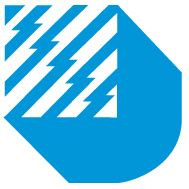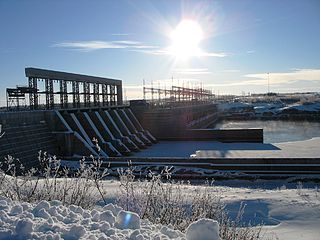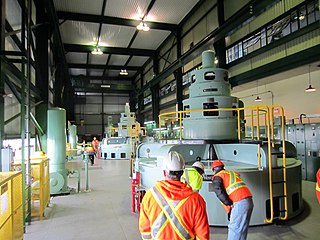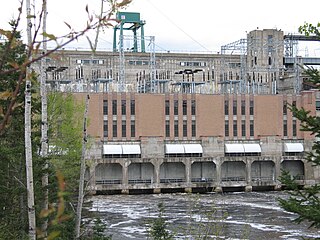
The economy of Quebec is diversified and post-industrial with an average potential for growth. Manufacturing and service sectors dominate the economy. If Quebec were a country, its economy would be ranked the 33rd largest in the world just behind Norway. Quebec is also ranked the 21st largest in the Organisation for Economic Co-operation and Development. The economy of Quebec represents 19.65% of the total GDP of Canada.

Hydro-Québec is a public utility that manages the generation, transmission and distribution of electricity in the Canadian province of Quebec, as well as the export of power to portions of the Northeast United States.

The Société d'énergie de la Baie James is the company in charge of building the hydroelectric development known as the James Bay Project in northern Quebec. It was established in December 1971 by the Société de développement de la Baie James (SDBJ), a Crown corporation of the province of Quebec and became a wholly owned subsididiary of Hydro-Québec in 1978.

The James Bay Project refers to the construction of a series of hydroelectric power stations on the La Grande River in northwestern Quebec, Canada by state-owned utility Hydro-Québec, and the diversion of neighbouring rivers into the La Grande watershed. It is located between James Bay to the west and Labrador to the east, and its waters flow from the Laurentian Plateau of the Canadian Shield. The project covers an area the size of New York State and is one of the largest hydroelectric systems in the world. It has cost upwards of US$20 billion to build and has an installed generating capacity of 16,527 megawatts. If fully expanded to include all of the original planned dams, as well as the additional James Bay II projects, the system would generate a total of 27,000 MW, making it the largest hydroelectric system in the world. It has been built since 1974 by James Bay Energy (SDBJ) for Hydro-Québec.

New Brunswick Power Corporation, operating as NB Power, is the primary electric utility in the Canadian province of New Brunswick. NB Power is a vertically-integrated Crown Corporation wholly owned by the Government of New Brunswick and is responsible for the generation, transmission, and distribution of electricity. NB Power serves all the residential and industrial power consumers in New Brunswick, with the exception of those in Saint John, Edmundston and Perth-Andover who are served by Saint John Energy, Energy Edmundston, and the Perth-Andover Electric Light Commission, respectively.

The electricity sector in Canada has played a significant role in the economic and political life of the country since the late 19th century. The sector is organized along provincial and territorial lines. In a majority of provinces, large government-owned integrated public utilities play a leading role in the generation, transmission, and distribution of electricity. Ontario and Alberta have created electricity markets in the last decade in order to increase investment and competition in this sector of the economy.

The La Grande-1 (LG-1) is a hydroelectric power station on the La Grande River that is part of Hydro-Québec's James Bay Project. The station can generate 1,436 MW and was commissioned in 1994–1995. A run of the river generating station, it is one of only two generating stations of the James Bay Project that use a reservoir without any major water-level fluctuations. Thus, the amount of electricity generated by the station depends almost entirely on the water-flow of the river, which is largely controlled by upstream reservoirs and generating stations.
The electricity policy of Ontario refers to plans, legislation, incentives, guidelines, and policy processes put in place by the Government of the Province of Ontario, Canada, to address issues of electricity production, distribution, and consumption. Policymaking in the electricity sector involves economic, social, and environmental considerations. Ontario's electricity supply outlook is projected to deteriorate in the near future due to increasing demand, aging electricity supply infrastructure, and political commitments, particularly the phase-out of coal-fired generation. Policymakers are presented with a range of policy choices in addressing the situation, both in terms of overall system design and structure, and specific electricity generating technologies.
Crown corporations in Canada are government organizations with a mixture of commercial and public-policy objectives. They are directly and wholly owned by the Crown.
Énergir, formerly known as Gaz Métro, is an energy company with 520,000 customers in Quebec and the northeastern United States. It is the largest natural gas distribution company in Quebec, and, through subsidiaries, also produces electricity from wind. In the United States the company operates through subsidiaries in nearly fifteen states, where it produces electricity from hydraulic, wind and solar sources, in addition to being the leading electricity distributor and the sole natural gas distributor in Vermont.
Hydro-Québec is a government-owned public utility established in 1944 by the Government of Quebec. The company is in charge of the generation, transmission and distribution of electricity across Quebec. Its head office is located in Montreal.
The Autorité des marchés financiers (AMF) is the organisation responsible for financial regulation in the Canadian province of Quebec. It regulates the province's financial markets and provides assistance to consumers of financial products and services. As provided for under its incorporating legislation, the AMF's mission is to enforce the laws governing the regulation of the financial sector, notably in the areas of insurance, securities, deposit institutions and the distribution of financial products and services.
The Champlain Hudson Power Express (CHPE) is a proposed high-voltage direct current (HVDC) underwater and underground power cable project project linking the Quebec area to the New York City neighborhood of Astoria, Queens. Following completion of a review by the New York State Public Service Commission, construction is set to begin in 2022. The line is permitted and expected to be operational in 2025.
The proposed sale of NB Power was an attempted takeover of New Brunswick's government-owned public utility assets by Hydro-Québec, Canada's largest utility. Announced on October 29, 2009 by premiers Shawn Graham of New Brunswick and Jean Charest of Quebec, the deal ultimately collapsed in March 2010 after months of controversy.

The Menihek Hydroelectric Generating Station is a conventional hydroelectric generating station at Menihek Lake in Labrador. The dam and powerhouse are located in the Canadian province of Newfoundland and Labrador, 40 km (25 mi) south of the isolated town of Schefferville, Quebec and two First Nations communities: Matimekosh-Lac-John and Kawawachikamach. The generating station, two 69 kV power lines and the distribution networks in each community form an independent electricity network, off the main North American grid.

The Tracy Thermal Generating Station is a retired 660-megawatt heavy fuel oil-fueled thermal power station built from 1962 by the Shawinigan Water & Power Company and completed by Hydro-Québec after the buyout of all private electric utilities by the government of Quebec in 1963. Commissioned between 1964 and 1968, the plant is located on the banks of the Saint Lawrence River in the city of Sorel-Tracy, in the Montérégie Region.

The Rapide-Blanc generating station is a hydroelectric facility, comprising a reservoir, a dam and a hydroelectric plant. It is located on the Saint-Maurice River about sixty kilometres (37 mi) north of the city of La Tuque, in Quebec, in Canada. Built between 1930 and 1934 by the Shawinigan Water & Power Company (SWPC), it is the third hydroelectric facility on this river. The plant has been operated by Hydro-Québec since it was acquired from the SWPC in 1963, as part of the nationalisation of electric power companies in Quebec. The plant has a rated power of 204 megawatts (274,000 hp).
Thierry Vandal is a Canadian businessman. He has been the President and Chief Executive Officer of Hydro-Québec since 2005. Vandal announced in January 2015 that he was stepping down front his role and is scheduled to leave on May 1, 2015.
The privatization of the electricity sector in Cameroon refers to the process by which the generation, transmission, distribution, and sale of electricity in Cameroon has been transferred from the state to the private sector. This includes the sale of assets and the granting of concessions to the private sector. The landmark event of this process is the sale of 56% of the Société National d'Electricité (SONEL), the fully integrated public company responsible for the generation, transmission, distribution, and sale of electricity in Cameroon, to AES Corporation in 2001. The deal also granted concessions for each sub-sector to the newly formed AES-SONEL company. The new regulatory framework to prepare for this privatization was implemented between 1998 and 2000.










